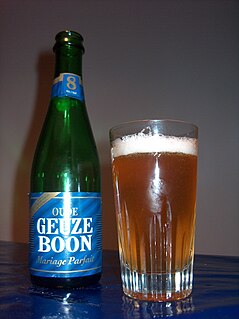
Whisky or whiskey is a type of distilled alcoholic beverage made from fermented grain mash. Various grains are used for different varieties, including barley, corn, rye, and wheat. Whisky is typically aged in wooden casks, generally made of charred white oak.

Syrah, also known as Shiraz, is a dark-skinned grape variety grown throughout the world and used primarily to produce red wine. In 1999, Syrah was found to be the offspring of two obscure grapes from southeastern France, Dureza and Mondeuse Blanche. Syrah should not be confused with Petite Sirah, a cross of Syrah with Peloursin dating from 1880.

Cognac is a variety of brandy named after the town of Cognac, France. It is produced in the surrounding wine-growing region in the departments of Charente and Charente-Maritime.
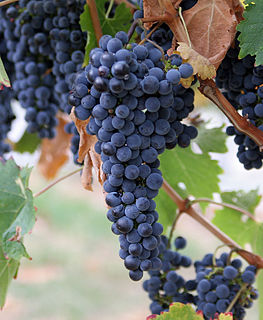
Winemaking or vinification is the production of wine, starting with the selection of the fruit, its fermentation into alcohol, and the bottling of the finished liquid. The history of wine-making stretches over millennia. The science of wine and winemaking is known as oenology. A winemaker may also be called a vintner. The growing of grapes is viticulture and there are many varieties of grapes.
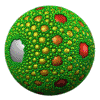
Transparency is possible in a number of graphics file formats. The term transparency is used in various ways by different people, but at its simplest there is "full transparency" i.e. something that is completely invisible. Only part of a graphic should be fully transparent, or there would be nothing to see. More complex is "partial transparency" or "translucency" where the effect is achieved that a graphic is partially transparent in the same way as colored glass. Since ultimately a printed page or computer or television screen can only be one color at a point, partial transparency is always simulated at some level by mixing colors. There are many different ways to mix colors, so in some cases transparency is ambiguous.
Hybridisation may refer to:
Grignolino is a red Italian wine grape variety commonly grown in the Piedmont region. It makes light colored wines and rosés with very fruity aromas, strong acidity and tannins. The name Grignolino derives from the word grignole which means "many pips" in the local Piedmontese dialect of the Asti region. The abundance of pips, or seeds, contribute to the strong, bitter tannins associated with the wine. Modern winemaker try to avoid the excess tannins with gentle and slow pressings. Grignolino has two Denominazione di origine controllata (DOCs) that produce wine from it - Asti and Monferrato Casale.

Metaxa is a Greek amber spirit created by Spyros Metaxa in 1888. Its taste comes from the marriage of Muscat wines from the island of Samos, aged wine distillates, and Mediterranean botanicals.

Carbonic maceration is a winemaking technique, often associated with the French wine region of Beaujolais, in which whole grapes are fermented in a carbon dioxide rich environment prior to crushing. Conventional alcoholic fermentation involves crushing the grapes to free the juice and pulp from the skin with yeast serving to convert sugar into ethanol. Carbonic maceration ferments most of the juice while it is still inside the grape, although grapes at the bottom of the vessel are crushed by gravity and undergo conventional fermentation. The resulting wine is fruity with very low tannins. It is ready to drink quickly but lacks the structure for long-term aging. In the most extreme case, such as with Beaujolais nouveau, the period between picking and bottling can be less than six weeks.

Red wine is a type of wine made from dark-colored (black) grape varieties. The actual color of the wine can range from intense violet, typical of young wines, through to brick red for mature wines and brown for older red wines. The juice from most purple grapes is greenish-white, the red color coming from anthocyan pigments present in the skin of the grape; exceptions are the relatively uncommon teinturier varieties, which produce a red-colored juice. Much of the red-wine production process therefore involves extraction of color and flavor components from the grape skin.

The Rhône wine region in Southern France is situated in the Rhône valley and produces numerous wines under various Appellation d'origine contrôlée (AOC) designations. The region's major appellation in production volume is Côtes du Rhône AOC.
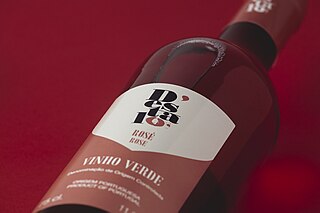
A rosé is a type of wine that incorporates some of the color from the grape skins, but not enough to qualify it as a red wine. It may be the oldest known type of wine, as it is the most straightforward to make with the skin contact method. The pink color can range from a pale "onion-skin" orange to a vivid near-purple, depending on the varietals used and winemaking techniques. There are three major ways to produce rosé wine: skin contact, saignée, and blending. Rosé wines can be made still, semi-sparkling or sparkling and with a wide range of sweetness levels from highly dry Provençal rosé to sweet White Zinfandels and blushes. Rosé wines are made from a wide variety of grapes and can be found all around the globe.

In chemistry, sigma bonds are the strongest type of covalent chemical bond. They are formed by head-on overlapping between atomic orbitals. Sigma bonding is most simply defined for diatomic molecules using the language and tools of symmetry groups. In this formal approach, a σ-bond is symmetrical with respect to rotation about the bond axis. By this definition, common forms of sigma bonds are s+s, pz+pz, s+pz and dz2+dz2 . Quantum theory also indicates that molecular orbitals (MO) of identical symmetry actually mix or hybridize. As a practical consequence of this mixing of diatomic molecules, the wavefunctions s+s and pz+pz molecular orbitals become blended. The extent of this mixing depends on the relative energies of the MOs of like symmetry.

Tannat is a red wine grape, historically grown in South West France in the Madiran AOC, and is now one of the most prominent grapes in Uruguay, where it is considered the "national grape". It is also grown in Argentina, Australia, Brazil, Peru, South Africa, Bolivia, and in the Italian region of Apulia, where it is used as a blending grape. In the US states of Maryland and Virginia, there are small experimental plantings of the vine, and plantings in California have increased dramatically in the first years of the 21st Century. It also shows great promise in Arizona and Oregon. Tannat wines produced in Uruguay are usually quite different in character from Madiran wines, being lighter in body and lower in tannins. It is also used to make Armagnac and full bodied rosé. In France, efforts to solve the harsh tannic nature of the grape led to the development of the winemaking technique known as micro-oxygenation.
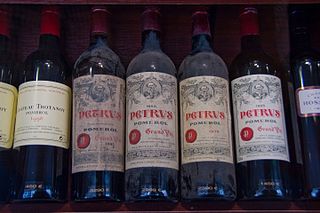
Wine fraud relates to the commercial aspects of wine. The most prevalent type of fraud is one where wines are adulterated, usually with the addition of cheaper products and sometimes with harmful chemicals and sweeteners.

Ontario wine is Canadian wine produced in the province of Ontario that is certified by VQA Ontario. Wines made from 100% Ontario grapes can qualify for classification under Ontario's appellation system, the Vintners Quality Alliance (VQA), and must be certified by the provincial wine authority to use the descriptor "Ontario wine" and other regulated labelling terms. VQA regulates production standards including grape varietals, wine-making techniques employed, and other requirements and ensures label integrity for consumers. This has raised some issues with certain wineries that do not meet the VQA standard or are not eligible because they use Ontario grown winter-hardy hybrid grapes that are not recognized by VQA despite lobbying attempts to update their list of acceptable grape varieties.

Stem-mixing is a method of mixing audio material based on creating groups of audio tracks and processing them separately prior to combining them into a final master mix. Stems are also sometimes referred to as submixes, subgroups, or busses.

In sound recording and reproduction, audio mixing is the process of combining multitrack recordings into a final mono, stereo or surround sound product. These tracks that are blended together are done so by using various processes such as equalization and compression. Audio mixing techniques and approaches can vary widely, and due to the skill-level or intent of the mixer, can greatly affect the qualities of the sound recording.

Cristom Vineyards is an Oregon wine producer and vineyard based near Salem, U.S. It is in the Eola-Amity Hills wine region within the Willamette Valley AVA, about 6 miles (9.7 km) northwest of Keizer.

